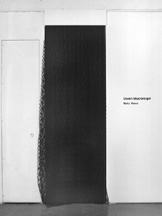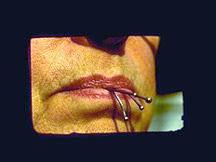- MAIN INDEX | ARTIST INDEX
| May 13 - June 18, 1994 Gwen MacGregor
| |
 Gwen MacGregor, "Murky Waters", detail, 1994. Photo Peter MacCallum. 18K | |
 Gwen MacGregor, detail view, slide mounted in gallery, 1994. Photo Peter MacCallum. 18K |  Gwen MacGregor, installation view clay bed imbedded by 3000 pins, 1994. Photo Peter MacCallum. 18K |
| Brochure Text: Over the past three years, Gwen MacGregor has divided her time between London, England and Toronto. When in London, she participates in the activity of mudlarking - the digging up of objects from the banks of the Thames. For a few Londoners, mudlarking is a profession, and metal detectors are used to locate jewellery, coins and precious metals washed up over time by the tides. Within view of the Tower Bridge and the Tower of London, the site of this activity, is the oldest area of the city which for centuries was the location of London's busy port. Here, MacGregor retrieved thousands of dress pins and toggles, which had been left behind by the professionals who carry out serious archaeological digs. In the darkened gallery, a shaft of light falls upon thousands of shining, crooked golden pins and delicate metal triangles, which pierce a slab of blackened clay like the mud they were scavenged from, the block of clay will dry and crack over time. The hand hammered triangles are toggles, decorative metal pieces from collars and clothing, and like the pins, date from Elizabethan to Victorian times. The pins were worn by women as part of their clothing, to hold collars, cuffs, lace and ribbons in place. They also served in the making of lace, to hold threads in place on small, stuffed pillows. As objects, the pins are charged with history and intimacy, the only remaining trace of the women's bodies and clothing, they once touched. Sunk into the gallery walls are three backlit slide images: a hand in a rubber glove in the mud, pins held in a woman's mouth and a historical illustration of lacemaking. Here the glove is a contemporary representation of the artistic process, as well as a latex layer of protection against the diseased mud of the Thames. Surprisingly, it is not the risk of contact with chemicals or sewage that is dangerous, but the fatal infection derived from the high concentration of odourless but deadly rat urine present in the mud. Danger and comfort co-exist in the second image of a woman's mouthful of pins. A personal memory of the artist's mother - skilled at dressmaking, knitting and embroidery - the image relates to the artist's childhood, as well as to the history of needlework, traditionally a woman's art form. In the last slide, an illustration from a Victorian Encyclopaedia of Needle work, the correct placement of pins in the making of lace is shown. The image is a curious one, the long nimble fingers of the woman echoing the shape of the slender bobbins she manipulates. Due to the lack of recorded history relating to women's culture, MacGregor was unable to confirm the pins' use in any book, nor in the Victoria and Albert Museum's extensive clothing collection. The definitive purpose of the pins and toggles was revealed to the artist by the unofficial, or colloquial historians who she met mudlarking. The tension created between official, accepted history and the personal or known, informs much of MacGregor's work. An earlier installation, entitled Non-Returnable, incorporated hundreds of clay smoking pipes, excavated from the same river banks. The pipes, and here the pins, are material evidence of the artistic process - the scavenged remains of the artist's cultural history. In its totality, Murky Waters can be seen as the difficult and confusing search for a cultural identity, a consideration of the artist's own past through the detritus of discarded, worthless artifacts.
Gwen MacGregor has exhibited throughout Canada over the past nine years. She also exhibits with the Blanket and Spontaneous Combustion artist collectives. She will be exhibiting at Atlantis Arts in London, England in October 1994 with Spontaneous Combustion.
| |